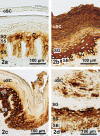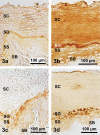Immunohistochemical demonstration of keratins in the epidermal layers of the Malayan pangolin (Manis javanica), with remarks on the evolution of the integumental scale armour
- PMID: 24085276
- PMCID: PMC3794358
- DOI: 10.4081/ejh.2013.e27
Immunohistochemical demonstration of keratins in the epidermal layers of the Malayan pangolin (Manis javanica), with remarks on the evolution of the integumental scale armour
Abstract
Using immunohistochemistry, the study demonstrates the distribution of keratins (pan-keratin with CK1-8, 10, 14-16, 19; keratins CK1, 5, 6, 9, 10; hair keratins AE13, AE14) in the epidermis of the Malayan pangolin (Manis javanica). A varying reaction spectrum was observed for pan-keratin, with body region-dependent negative to very strong reaction intensities. The dorsolateral epidermis exhibited positive reactions only in its vital layers, whereas the abdominal epidermis showed strong positive reactions in the soft two outer strata. The single acidic and basic-to-neutral (cyto)keratins produced clear variations compared to the pan-keratin tinging. E.g., CK1 appeared in all epidermal layers of both body regions, except for the ventral stratum corneum, whereas CK5, 6, 9, 10 were restricted to the soft ventral epidermis. Here, distinctly positive reactions were confined to the stratum granulosum, except for CK6 that appeared in the soft stratum corneum. A different staining pattern was obvious for the hair keratins, i.e., positive reactions of AE13 concentrated only in the granular layer of the dorsal epidermis. In the abdominal epidermis, remarkable tinging for AE14 was visible in the stratum basale, decreasing toward the corneal layer, but was also found in the outer root sheath cells of the hair follicles in the ventral body part. Our findings are discussed related to the evolution of the horny dorsal scales of the pangolin, which may have started from the tail root, projecting forward to the head.
Figures




References
-
- Murphy WJ, Eizirik E, O’Brien SJ, Madsen O, Scally M, Douady CJ, et al. Resolution of the early placental mammal radiation using bayesian phylogenetics. Science 2001;294:2348-51 - PubMed
-
- Francis CM. A field guide to the mammals of South-East Asia. New Holland Publ., London, UK, 2008
-
- Gaudin TJ, Emry RJ, Wible JR. The phylogeny of living and extinct pangolins (Mammalia, Pholidota) and associated taxa: A morphology based analysis. J Mammal Evol 2009;16:235-30
-
- Meyer W, Liumsiricharoen M, Hornickel I, Suprasert A, Schnapper A, Fleischer LG. Demonstration of substances of innate immunity in the integument of the Malayan pangolin (Manis javanica). Eur J Wildl Res 2010;56:287-96
MeSH terms
Substances
LinkOut - more resources
Full Text Sources
Other Literature Sources
Research Materials

